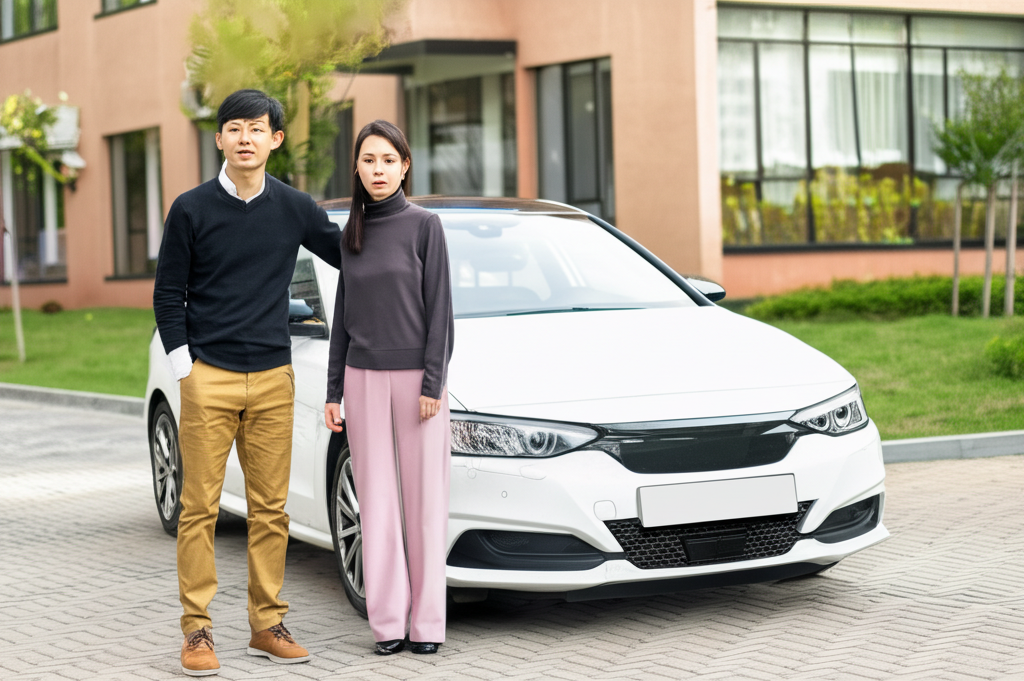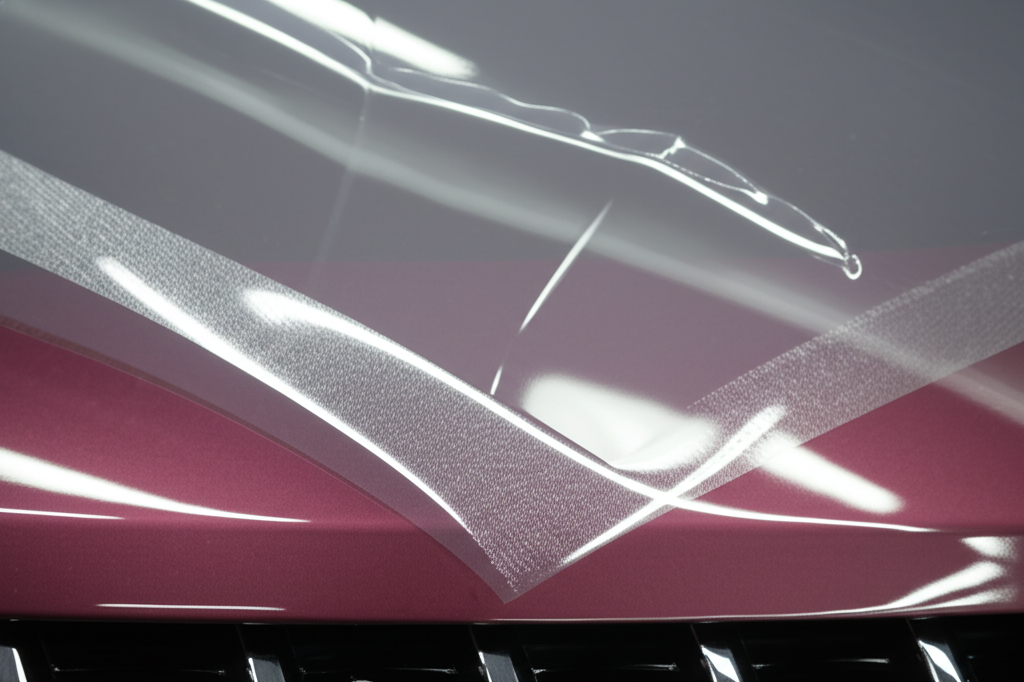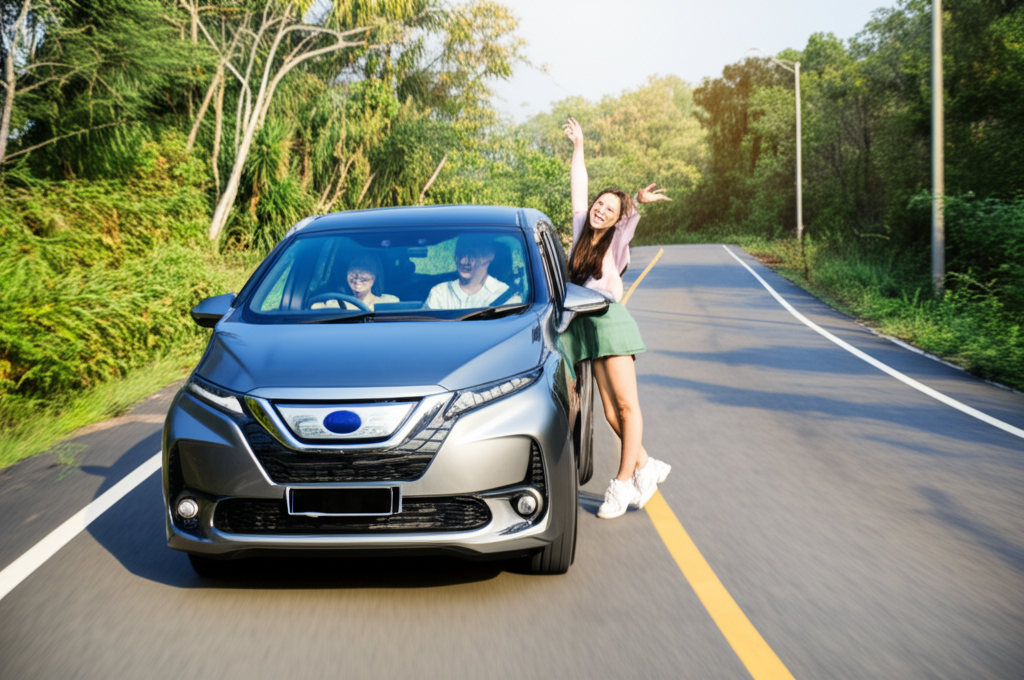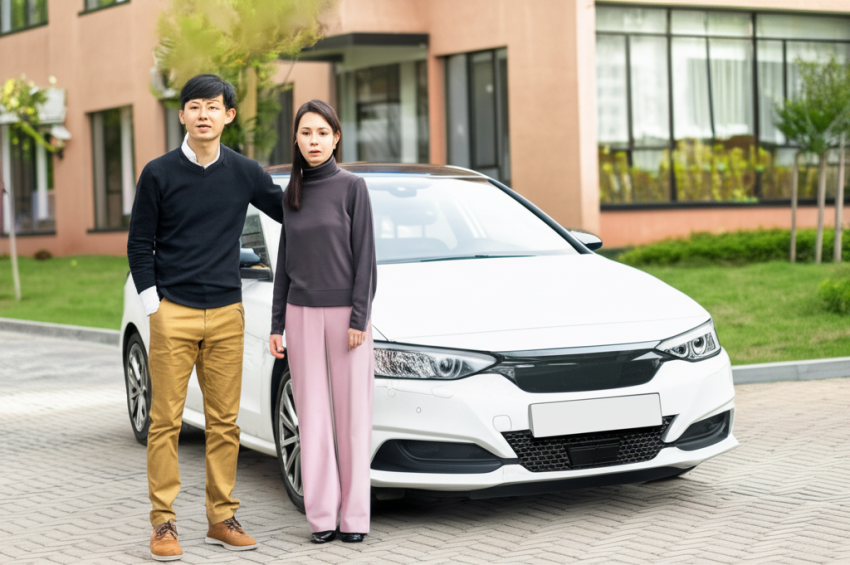Remember that incredible feeling? Driving your brand-new car home, the pristine paint gleaming under the Thai sun, the new car smell filling the cabin… It’s pure joy! But for many young couples, especially first-time car owners in Thailand, that excitement quickly mixes with a nagging anxiety. The thought of navigating busy Bangkok streets, squeezing into tight parking spots, or even just driving on highways where debris flies unexpectedly can be terrifying. What if that perfect paint gets scratched? What if a rogue motorbike brushes too close? Suddenly, the dream car feels more like a fragile treasure you’re almost afraid to use. This fear is real: the fear of the first scratch, the fear that diminishes the joy of ownership. Does protecting your investment mean sacrificing peace of mind, or is there a solution? Specifically, is investing in TPU Paint Protection Film (PPF) truly worth it for new car owners like you?

From Showroom Shine to Road-Ready Confidence: Art and Pim’s Story
Meet Art and Pim, a young professional couple in Bangkok who recently purchased their first car together – a sleek, dark grey Honda Civic. They were ecstatic. It represented a milestone, freedom, and countless future road trips exploring Thailand’s beauty. However, the reality of Bangkok traffic hit hard. “Honestly, the first week, we barely drove it,” admits Art. “Every time we thought about taking it out, we pictured motorbikes squeezing past in traffic, loose gravel on detour roads, or even just careless door dings in the condo parking lot. It was stressful!”
Pim adds, “We spent so much time researching the car, saving up, and finally choosing the perfect colour. The thought of it getting damaged almost immediately was heartbreaking. We started looking into protective options. Ceramic coating seemed popular, but we were worried it wouldn’t be enough against physical impacts like scratches or stone chips, which felt like the biggest threats here.”
Their research led them to high-quality Thermoplastic Polyurethane (TPU) Paint Protection Film. While initially hesitant about the cost, they visited a reputable installer who demonstrated the film’s properties: its thickness, its self-healing capabilities for minor swirls, and its incredible clarity. They explained how TPU PPF acts like an invisible shield, absorbing the impact from minor scratches, stone chips, bird droppings, bug splatter, and even the harsh Thai UV rays that can fade paint over time.
Art and Pim decided to invest in a full front-end package (bonnet, front bumper, fenders, headlights, side mirrors) – the areas most vulnerable to damage. The installation took a couple of days, involving meticulous cleaning and precise application of the film. “Seeing the process was reassuring,” says Art. “They were incredibly careful, wrapping the edges for a seamless look. When we picked it up, you honestly couldn’t tell it was there unless you looked extremely closely at certain edges. The gloss was amazing, maybe even better than the original!”
The real change? Their mindset. “It was like a weight lifted,” Pim smiles. “Suddenly, we weren’t constantly scanning the road for threats or panicking about tight parking spaces. We drove to Hua Hin the following weekend, and even when we heard small pebbles hitting the front on the highway, we weren’t wincing. We could finally just *enjoy* our new car.” They still practice careful driving and parking, but the constant, underlying fear is gone, replaced by confidence. Their beautiful Civic still looks showroom-new months later, despite daily commuting in the city.

Understanding Your Options: TPU PPF vs. Alternatives
So, what exactly is TPU PPF, and how does it stack up against doing nothing or opting for other treatments like ceramic coatings? Let’s break it down. TPU PPF is a durable, transparent, and flexible film applied directly to your car’s paintwork. Its primary function is physical protection against external damage.
Here’s a comparison to help you understand the differences:
| Feature | High-Quality TPU PPF | Ceramic Coating | Basic Wax/Sealant | No Protection |
|---|---|---|---|---|
| Primary Protection | Physical impact (stone chips, scratches, swirls), Chemical stains (bird droppings, bug guts), UV rays | Chemical resistance, UV protection, Enhanced gloss, Hydrophobicity (water beading) | Minor UV protection, Temporary gloss enhancement, Basic water beading | None |
| Scratch Resistance | Excellent against minor to moderate scratches, swirls, wash marks | Good against very light swirls/micro-marring, but offers minimal impact protection | Very minimal | Paint is fully exposed |
| Self-Healing | Yes (most quality TPU films self-heal minor swirls/scratches with heat) | No | No | No |
| Material | Thermoplastic Polyurethane (flexible, durable polymer) | Liquid Polymer (SiO2 or SiC based), cures to a hard layer | Natural Carnauba Wax or Synthetic Polymer Sealant | N/A |
| Durability / Lifespan (Thailand Climate) | 5-10+ years (with proper care, depending on brand/quality) | 1-5+ years (depending on type, maintenance) | Weeks to Months | N/A |
| Appearance | Optically clear, enhances gloss, virtually invisible. Some matte options available. | Significantly enhances gloss and depth of colour. | Adds temporary gloss. | Original paint finish (prone to degradation) |
| Approx. Price Range (Full Front End – Sedan, Thailand) | ฿25,000 – ฿60,000+ (depends on film brand, coverage, installer) | ฿8,000 – ฿30,000+ (depends on brand, layers, warranty) | ฿500 – ฿3,000 (DIY or professional) | ฿0 |
| Ideal For | Owners prioritizing maximum physical protection, preserving paint condition & resale value, seeking peace of mind against daily driving hazards. Especially good for new cars. | Owners wanting easier cleaning, enhanced gloss, and protection against environmental contaminants, but less concerned about physical impacts. Can be applied over PPF. | Budget-conscious owners wanting basic shine and minimal temporary protection. Requires frequent reapplication. | Not recommended for maintaining vehicle appearance or value. |
Why TPU Matters:** Not all PPF is created equal. Older PVC (Polyvinyl Chloride) films exist, which are cheaper but tend to yellow faster, become brittle, offer less protection, and can potentially damage paint upon removal. High-quality TPU films are the modern standard, offering superior clarity, flexibility, durability, self-healing properties, and clean removability.
PPF and Ceramic Coating Together? Yes! Many owners choose to apply a ceramic coating *over* the PPF. This combines the physical protection of PPF with the enhanced gloss, hydrophobicity (water repellency), and ease of cleaning provided by ceramic coatings. It’s the ultimate protection package, albeit at a higher combined cost.
Real Voices: Thai Car Owners Share Their PPF Experience
It’s not just Art and Pim who found peace of mind. Here’s what other new car owners in Thailand had to say after getting TPU PPF:
“I was on the fence because of the price for my new Mazda 3. But after getting stuck behind a construction truck on the motorway and hearing gravel hit the front, I was SO glad I had the PPF. Checked later, not a single mark on the paint! The film took the hits. Before PPF, I would have been obsessing over potential chips. Now, I just drive.” – Natt, Chiang Mai
“My wife uses our new SUV for the school run in Phuket. Tight roads, lots of bikes, kids bumping doors in the parking lot… it was nerve-wracking. We got full PPF coverage. The best part is the self-healing. Minor scuffs from bushes or loading things just disappear in the sun. It keeps the car looking perfect, which makes my wife happy and less stressed.” – David, Phuket
“Living in Bangkok, bird droppings and tree sap are constant issues, besides the scratches. My previous car’s paint got etched badly. With the PPF on my new MG, I just wipe contaminants off easily, even if they sit for a bit. No more panic about permanent paint damage. It maintains the car’s value, which was important for me.” – Suda, Bangkok
The common thread? A significant shift from anxiety and worry to confidence and enjoyment. The initial investment translates directly into daily peace of mind and preserves the car’s aesthetic and financial value.
Ready to Drive Worry-Free? Protect Your Investment
If you’re like Art and Pim, Natt, David, or Suda – proud of your new car but anxious about preserving its perfect condition amidst the realities of Thai roads – then high-quality TPU Paint Protection Film is a serious consideration. It’s more than just a film; it’s an investment in peace of mind, allowing you to truly enjoy your new vehicle without the constant fear of that first, inevitable scratch or chip.
Stop letting anxiety take the driver’s seat. Protect your paint, preserve your car’s value, and reclaim the joy of driving your new car. Want to learn more about the best TPU PPF options for your specific model and driving needs in Thailand? Get a personalized quote and expert advice today.
📱 Want to learn more about car wrap & paint protection?
Feel free to reach us on LINE:

🌐 Official Website: https://tpuwraps.com
Frequently Asked Questions (FAQ)
- Q: Is TPU PPF really worth the high cost?
- A: It depends on your priorities. If maintaining your car’s pristine condition, maximizing resale value, and reducing stress about scratches and chips are important to you, then yes, many owners find it’s worth the investment. Consider the cost of potential paint repairs (which may never match perfectly) versus the one-time cost of PPF for years of protection.
- Q: How long does TPU PPF last in the Thai climate?
- A: Quality TPU films from reputable brands typically come with warranties ranging from 5 to 10 years or even longer. Durability depends on the film quality, installation expertise, and how well you maintain it (regular washing, avoiding harsh chemicals). Thailand’s heat and UV intensity are factors, but premium films are designed to withstand these conditions without yellowing or cracking prematurely.
- Q: Will PPF damage my car’s original paint?
- A: High-quality TPU PPF installed by professionals should not damage your factory paint. In fact, it protects it. The adhesives used are designed to be safe for automotive paint. Issues usually arise only with low-quality films (like older PVC types) or improper installation/removal techniques.
- Q: How do I care for a car with PPF?
- A: Caring for PPF is relatively simple. You can wash your car as usual (hand washing is often recommended). Avoid high-pressure washing too close to the film edges. Most manufacturers recommend waiting a week or so after installation before washing. Specific care products for PPF exist, but regular car wash soap is generally fine. Many owners apply a ceramic coating or sealant over the PPF for added ease of cleaning and hydrophobicity.
- Q: Can PPF be applied to only certain parts of the car?
- A: Absolutely. Common packages include ‘Full Front’ (bumper, bonnet, fenders, mirrors, headlights), ‘Partial Front’ (part of bonnet and fenders), or even just high-impact areas like the front bumper or door edges/cups. You can customize the coverage based on your budget and protection needs. Full car wraps offer complete protection but are the most expensive option.
Conclusion: Invest in Protection, Drive with Confidence
Buying a new car is a significant moment, filled with excitement and pride. Don’t let the fear of scratches, stone chips, and the unavoidable hazards of driving in Thailand diminish that joy. High-quality TPU Paint Protection Film offers a tangible solution, acting as an invisible shield that preserves your car’s showroom shine and, more importantly, gives you the confidence to hit the road without constant worry.
Think of it not just as an expense, but as an investment in maintaining your car’s beauty, preserving its resale value, and ensuring your ownership experience is as enjoyable and stress-free as possible from day one. Ready to explore Thailand in your new ride, fully protected and worry-free?

